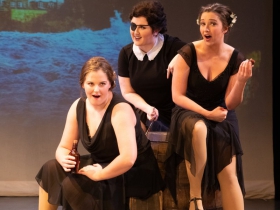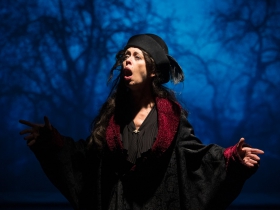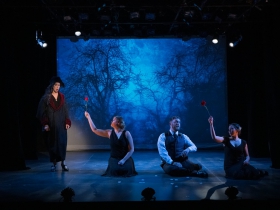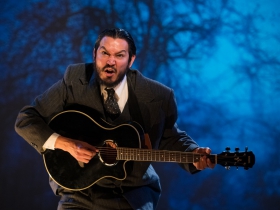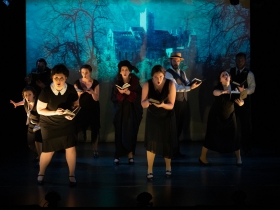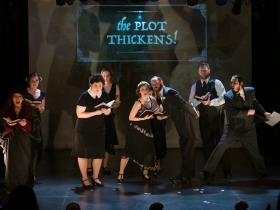A ‘Ruddigore’ For the Ages
Skylight production of less-known Gilbert & Sullivan operetta is clever, funny and smartly sung.
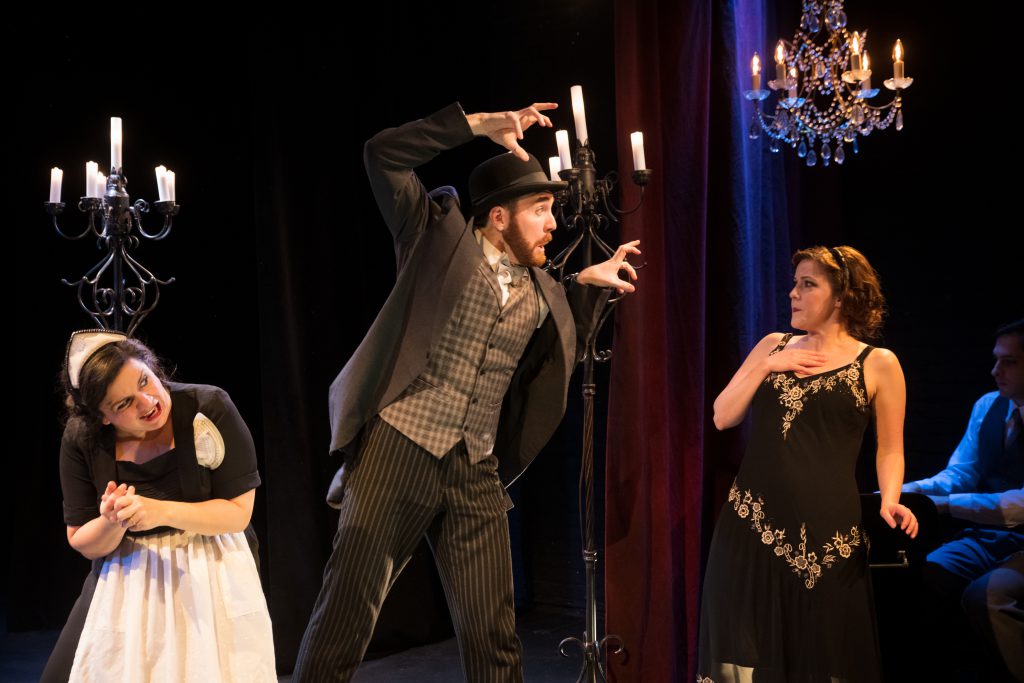
(l. to r.) Karen Estrada (Old Adam Goodheart), Doug Clemons (Robin Oakapple/Ruthven Murgatroyd), and Susan Robinson (Rose Maybud) in Ruddigore running January 3 – January 19, 2020. Photo by Mark Frohna.
Over the decades, Skylight Music Theatre has done some 50 odd productions of Gilbert and Sullivan operettas. None, I dare to say, were odder or more audaciously invigorating than the current Ruddigore (or the Witch’s Curse) enjoying a truncated run not in the Skylight’s normal proscenium Cabot Theatre, but in the 99-seat Studio Theater, which means you’d better rush to the Broadway Theatre Center before January 19 as there are far fewer tickets than usual.
Ruddigore is the least known or performed of the G&S canon, not because Arthur Sullivan’s musical nimbleness is any less than lively or W.S. Gilbert’s word play any less amusing. In fact, his fun with British Isles place names has never been grander. But the plot gimmickry! Elements of a curse on every Murgatroyd baronet down through the ages and the personality confusions of generations of lovesick relatives signal a Gilbert comic plot fetish running amuck. This could do a production in.
Every voice blends in operetta stylings, while the stagecraft envisions an acting manner of melodramatic broadness that fits the antics and the goofy home-grown (but expertly polished) staging. Co-directors Catie O’Donnell and particularly Jill Anna Ponasik (whose sense of impish found music has become well known to both MOT and as an associate at the Skylight) assemble the singers as prancing choruses and commentators, used as both comic foils and furniture along the way. Several singers step in for powerful solo turns, but all also serve as orchestral anchors, creeping toward the audience, fluttering backwards or breaking apart into trios and quartets.
We cannot pretend that this is not different than the full orchestration usually delivering Sullivan’s music (which has often in theater been reduced to an instrumental ensemble). But the use of voices as harmonics or as percussive tra-la-las adds a particular charm and speed, conveying the coloration highlights of Sullivan’s music. Nor should we pretend that the mannered D’Oyly Carte school of presentation is visible in any fashion but a sly mockery and spin room of operetta expectations. And I say Bravo!
Perhaps it “really doesn’t matter” except to a few patter purists, but this method exposes the slightest overlaps in the patter exactitude for which Gilbert was famous. We have group voices and undertones doing rhymes that are usually set apart as pristine jewels. Here they plunge into the mischief. That’s a revelation you realize after being carried off by the stage energy and skill of the creators.
Doug Clemons provides a constant cheerful comic veneer and Buster Keaton agility as the lovesick Robin while the heartless ingénue Rose is amusingly grinned and magnificently sung by Susan Robinson. Her purpose time and again, it seems, is to stagger the audience with her high notes soaring out of the crowd onstage.
As Mad Margaret, the thwarted lover in the horror wig, Diane Lane is once again the most powerful mezzo in captivity, while comic flourishes and big notes are also delivered by Karen Estrada as the most intrusive man servant a baron ever had.
All these performers reveled in the comic facial takes as well as the singing. And while there is still room to further develop the acting methods there is nothing to fault in the musical timing and strength of Adam Qutaishat and newcomer Shayne Steliga as the sidemen of the romantic antics. Also musically exceptional and perfect comedic foils were Sandi Lash, Katie Gruell, Edward Lupella and Megan McCarthy – all of whom should hang this outing prominently on their resumes.
Ruddigore Gallery
Dominique Paul Noth served for decades as film and drama critic, later senior editor for features at the Milwaukee Journal. You’ll find his blog here and here.
Review
-
Eating Burmese in Bay View
 Dec 13th, 2025 by Cari Taylor-Carlson
Dec 13th, 2025 by Cari Taylor-Carlson
-
Casablanca Is a Milwaukee Success
 Nov 30th, 2025 by Cari Taylor-Carlson
Nov 30th, 2025 by Cari Taylor-Carlson
-
Oh, Those Witty 18th Century Brits
 Nov 24th, 2025 by Dominique Paul Noth
Nov 24th, 2025 by Dominique Paul Noth
Theater
-
Oh, Those Witty 18th Century Brits
 Nov 24th, 2025 by Dominique Paul Noth
Nov 24th, 2025 by Dominique Paul Noth
-
Skylight’s Holiday Show Is Lots of Fun
 Nov 16th, 2025 by Dominique Paul Noth
Nov 16th, 2025 by Dominique Paul Noth
-
Rep’s ‘Come From Away’ Is a Triumph
 Nov 10th, 2025 by Dominique Paul Noth
Nov 10th, 2025 by Dominique Paul Noth

